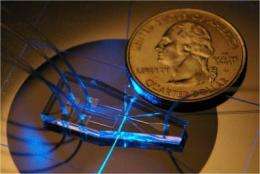Biochip-based device for cell analysis

(Phys.org) -- Inexpensive, portable devices that can rapidly screen cells for leukemia or HIV may soon be possible thanks to a chip that can produce three-dimensional focusing of a stream of cells, according to researchers.
"HIV is diagnosed based on counting CD4 cells," said Tony Jun Huang, associate professor of engineering science and mechanics, Penn State. "Ninety percent of the diagnoses are done using flow cytometry."
Huang and his colleagues designed a mass-producible device that can focus particles or cells in a single stream and performs three different optical assessments for each cell. They believe the device represents a major step toward low-cost flow cytometry chips for clinical diagnosis in hospitals, clinics and in the field.
"The full potential of flow cytometry as a clinical diagnostic tool has yet to be realized and is still in a process of continuous and rapid development," the team said in a recent issue of Biomicrofluidics. "Its current high cost, bulky size, mechanical complexity and need for highly trained personnel have limited the utility of this technique."
Flow cytometry typically looks at cells in three ways using optical sensors. Flow cytometers use a tightly focused laser light to illuminate focused cells and to produce three optical signals from each cell. These signals are fluorescence from antibodies bound to cells, which reveals the biochemical characteristics of cells; forward scattering, which provides the cell size and its refractive index; and side scattering, which provides cellular granularity. Processingthese signals allows diagnosticians to identify individual cells in a mixedcell population, identify fluorescent markers and count cells and other analysis to diagnose and track the progression of HIV, cancer and other diseases.
"Current machines are very expensive costing $100,000," said Huang. "Using our innovations, we can develop a small one that could cost about $1,000."
One reason the current machines are so large and expensive is the method used to channel cells into single file and the necessary alignment of lasers and multiple sensors with the single-file cell stream. Currently, cells are guided into single file using a delicate three-dimensional flow cell that is difficult to manufacture. More problematic is that these current machines need multiple lenses and mirrors for optical alignment.
"Our approach needs only a simple one-layer, two-dimensional flow cell and no optical alignment is required," said Huang.
Huang and his team used a proprietary technology named microfluidic drifting to create a focused stream of particles. Using a curved microchannel, the researchers took advantage of the same forces that try to move passengers in a car to the outside of a curve when driving. The microfluidic chip's channelbegins as a main channel that contains the flow of carrier liquid and a second channel that comes in perpendicularly that carries the particles or cells. Immediately after these two channels join, the channel curves 90 degrees, which moves all the cells into a horizontal line. After the curve, liquid comes into the channel on both sides, forcing the horizontal line of cells into single file. The cells then pass through a microlaser beam.
An advantage of this microfluidic flow cytometry chip is that it can be mass-produced by molding and standard lithographic processes. The fibers for the optical-fiber delivered laser beams and optical signals already exist.
"The optical fibers are automatically aligned once inserted into the chip, therefore requiring no bulky lenses and mirrors for optical alignment," said Huang. "Our machine is small enough it can be operated by battery, which makes it usable in Africa and other remote locations."
The researchers tested the device using commercially available, cell-sized fluorescent beads. They are now testing the device with actual cells.
Provided by Pennsylvania State University


















